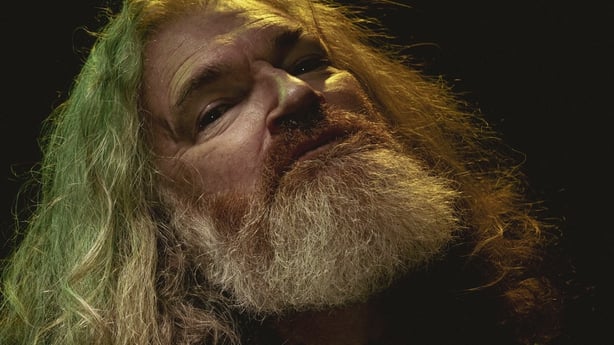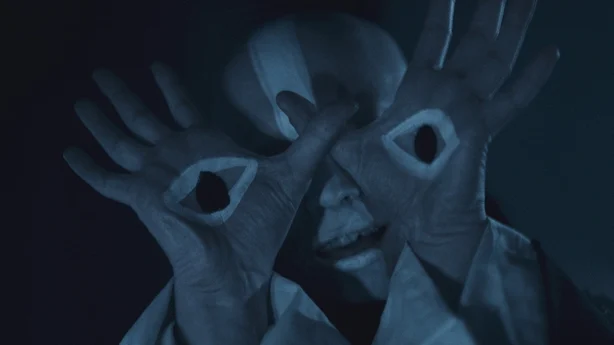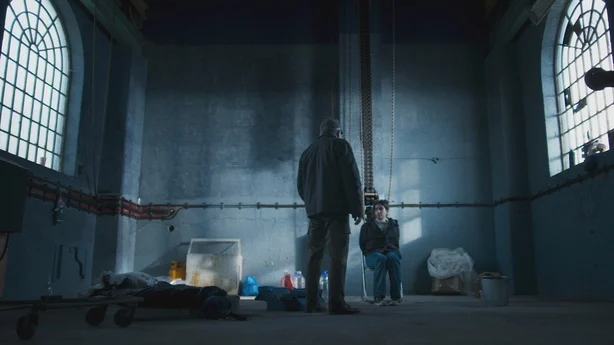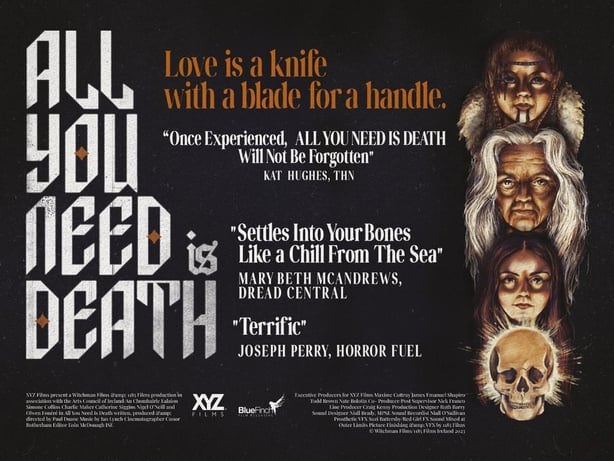So way back in June of 2021, with lockdown still ongoing, I decided to write, direct, produce and self-fund a low-budget horror film, for reasons too complicated to go into in this short piece.
The thing about making a low-budget horror film in the 2020s is that there are too many of them. Even at the bigger budgeted level of the studio franchise horror, there's too many, and at the lower-budgeted end where self-funded films like my own attempt, All You Need Is Death, the competition is even greater.
Before you even start working on a film aimed at that overcrowded niche market, horror movie fans, you need to think about what kind of hook your film might have for audiences.
When I started thinking about doing such a film, I had two possible hooks in my mind. I had been saturated in the music of the new Irish folk groups - Lankum, Lisa O’Neill, the Mary Wallopers, etc - for the past few years, and it seemed like the most exciting musical development from this country in my lifetime, traditional music played by people who turned it into something 21st century and exciting.
We need your consent to load this rte-player contentWe use rte-player to manage extra content that can set cookies on your device and collect data about your activity. Please review their details and accept them to load the content.Manage Preferences
Listen: All You Need Is Death - Paul Duane talks to Culture File
I had also been watching a lot of what’s called 'folk horror’ movies, a trend whose name first appeared perhaps to describe 2011’s Kill List but which has now been backdated to include much older films like Haxan or The Wicker Man. The trend has become a little hackneyed, to the point of there being a meme that goes "Folk horror is when someone discovers an unusual arrangement of twigs".
But I thought something new could yet be found in the subgenre, by combining it with the new music coming out of Ireland to create a folk-music-horror movie. I only needed to find a theme, and I found one by superimposing the 78 rpm record-collecting world I had dipped into in my documentary While You Live, Shine, on top of the ballad scene that’s currently flourishing in Ireland. Two people in search of rare, uncollected songs accidentally find one that’s taboo, and which might contain a curse leading to their destruction – that sounded like a horror movie plot to me, but different enough to what’s come before that it might stand a chance of succeeding in the outside world.

I had never written a script entirely on my own before, this was the first, and it was not particularly easy. But in two sustained periods of creative energy, October 2021 and February 2022, I got a seventy-page script written, the right sort of page count if you’re looking at a fifteen-day shoot (number of pages in script divided by number of shooting days is an easy way of working out how difficult your job is as a director).
The first person I sent the script to was Ian Lynch of Lankum. I didn’t know Ian but the reason I wanted to get him specifically rather than another member of the band, or the whole band, was that Ian is a huge horror fan, with a deep love for Poe and Lovecraft as well as the genre in its entirety, and also has academic qualifications – an M.Litt in Irish folklore. Basically he’s a human Venn diagram which intersects neatly with all of my film’s central concerns.
He got back and said that he loved it and wanted to do it. But he had never composed a movie soundtrack before, so it would be a learning curve for both of us. We figured out some gaps in Lankum’s schedule during which Ian could work on soundtrack music, and I organised a meeting between Ian and my brilliant sound editor/designer Niall Brady so the technical aspects could be worked out.

Casting the film was interesting as we had no budget for a casting director, so I just started asking around and ended up meeting Simone Collins, who I immediately locked in for the role of Anna. She was so good that I was extremely worried through the year leading up to the shoot that she would get cast in some massive role in a Netflix series and the film would lose her. She helped me find and cast Charlie Maher, an old friend of hers from the Lir acting school. I had known the brilliant Catherine Siggins since we were both teenagers, and had written parts specifically for Nigel O’Neill and Olwen Fouéré, so it’s lucky they accepted the parts.
The shoot was pretty gruelling, as I had specifically requested the grimmest, most dilapidated locations possible.
The crew, put together by my line producer, Craig Kenny, who had previously worked as First Assistant Director on Derry Girls and Ted Lasso, ended up being populated by a diverse bunch of young people from different countries and communities, often working above their usual pay grade. Our art department was 50% trans, our focus puller was Brazilian, our First Assistant Director was from Cork… you get the idea.

is that there are too many of them.'
The shoot was pretty gruelling, as I had specifically requested the grimmest, most dilapidated locations possible. This combined with the January weather and a schedule mostly made up of night shoots, well, the whole thing added up to a challenge, especially when I discovered my boots were leaking halfway through a rainy night filming in a car park.
However, people commented regularly that it was the most positive set they’d been on in a long time. I know for sure that wasn’t because of the money as everyone was on Union minimum, with some deferring their fees entirely. I think it was because people liked the script, liked being part of something that was being made outside the normal structures of Irish film, and liked being given a chance to do something that would stretch them and give them a new skill-set – most people on set worked a grade or two above their usual level, which gave everyone unusual amounts of responsibility.

The tiny budget we had would only cover the shooting of the film, not the post- production, so my co producer Nick Franco of 1185 Films took on a huge responsibility for the film when he agreed to do all the picture post for a deferred fee. Working in tandem with Eugene McCrystal at Outer Limits in Dublin, who handled the sound design and mix, we managed to get the film ready just in time for its premiere in October 2023 at Beyond Fest in Los Angeles.
The film has been travelling around the world since then, screening at film festivals, bringing a little bit of Irish subcultural weirdness into the world (or as the Sight & Sound magazine review said, "Hallucinatory chaos ensues"). But the most important screenings of it for me are in Ireland, and how Irish people respond to it is the most important response. I think there’s a lot in it that will only really be fully understood by Irish people, but if anyone anywhere in the world enjoys it and feels stimulated by it, that makes me very happy.
All You Need Is Death is on release now in selected cinemas nationwide.
Disclaimer: The copyright of this article belongs to the original author. Reposting this article is solely for the purpose of information dissemination and does not constitute any investment advice. If there is any infringement, please contact us immediately. We will make corrections or deletions as necessary. Thank you.






